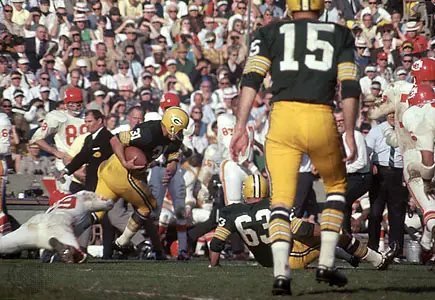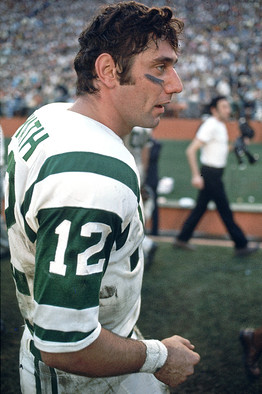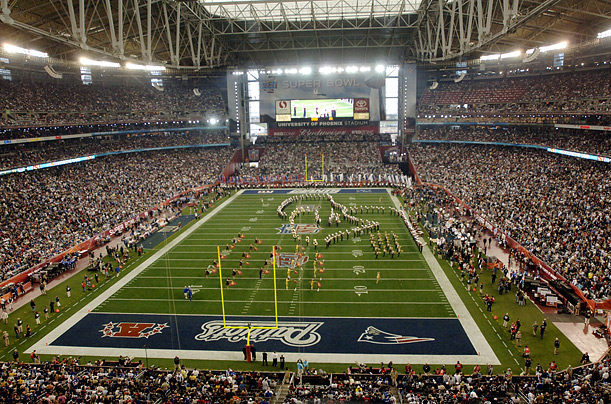 With the National Football League set to embark on its 50th edition of the Super Bowl this Sunday, you know that the league will be going all out to pay homage to the players and coaches that helped to make the big game what it is. But what about the leagues that helped to make the NFL the colassal monster that it currently is? In 1959, the American Football League was formed after businessmen such as Lamar Hunt and Bud Adams failed to land NFL franchises. And 23 years later, it would be United States Football League that would push the NFL. However neither the AFL nor USFL currently exist, but their mark is etched all over the NFL and the aspect of the Super Bowl.
With the National Football League set to embark on its 50th edition of the Super Bowl this Sunday, you know that the league will be going all out to pay homage to the players and coaches that helped to make the big game what it is. But what about the leagues that helped to make the NFL the colassal monster that it currently is? In 1959, the American Football League was formed after businessmen such as Lamar Hunt and Bud Adams failed to land NFL franchises. And 23 years later, it would be United States Football League that would push the NFL. However neither the AFL nor USFL currently exist, but their mark is etched all over the NFL and the aspect of the Super Bowl.
The American Football League began play in 1960 as a 10-team league. For the most part, AFL owners, coaches, and players alike were people who were overlooked by the National Football League as guys who could not cut it in their league. But what ensued over the next decade was what amounted to as being professional football’s version of the Civil War. At first the NFL didn’t take the AFL serious due to the fact that they thought of themselves as the gold standard. The NFL focused more on the blood, sweat, and tears that came with running the football consistently. For the players in the NFL, it was almost like being in the military as they could only have short hair, no facial hair, and their last names were not on the back of their jerseys. The AFL would provide fans with a more wide open variety brand of football that included more downfield passing, players who had their names on the back of their jerseys, and more importantly, an opportunity for them to express themselves with long hair and facial hair which was becoming the norm in the 1960’s.
Aside from the changes on the field, the American Football League pushed the National Football League for the top collegiate talent as it was a free-for-all in order to sign players. Quarterback Joe Namath was just one of many players that was drafted by both leagues. Coming out of the University of Alabama, Namath was drafted by the St. Louis Cardinals of the NFL, and the New York Jets of the AFL. However Namath chose the Jets and thus the legend of “Broadway Joe” was born. The battle for top-tier talent was wearing on both leagues as team owners were in the process of losing money due to the large sums of cash that they were shelling out to sign players. And in 1966, a treaty was signed by both leagues when they agreed to merge by 1970.
 Leading up to the merger, a championship game was created to showcase the winner of each league. Initially the game would be referred to as the AFL-NFL World Championship Game with the first edition taking place on January 15, 1967 at the Los Angeles Coliseum between the Green Bay Packers of the National Football League and the Kansas City Chiefs of the American Football League. During the 1960’s, the Packers were the gold standard of professional football as they won five NFL Titles and most people didn’t believe that the Chiefs deserved to be on the same field as them. The Packers would easily dispatch of the Chiefs 35-10, and the Oakland Raiders 33-14 a year later in the second edition of the title game that simply made the NFL supporters say “I told you so”.
Leading up to the merger, a championship game was created to showcase the winner of each league. Initially the game would be referred to as the AFL-NFL World Championship Game with the first edition taking place on January 15, 1967 at the Los Angeles Coliseum between the Green Bay Packers of the National Football League and the Kansas City Chiefs of the American Football League. During the 1960’s, the Packers were the gold standard of professional football as they won five NFL Titles and most people didn’t believe that the Chiefs deserved to be on the same field as them. The Packers would easily dispatch of the Chiefs 35-10, and the Oakland Raiders 33-14 a year later in the second edition of the title game that simply made the NFL supporters say “I told you so”.
But the title game would begin to become the true spectacle that it has evolved into during the third edition of the contest. By this time Hunt was the owner of the Chiefs and in a letter to National Football League commissioner Pete Rozzelle, he joked that the game should be referred to as the Super Bowl after watching his kids play with a “super ball”. The name would stick and the game would find some life on January 12, 1969 when the Jets took on the Baltimore Colts.

Joe Namath
The Colts were the overwhelming champions of the National Football League as they finished with a regular season record of 13-1. After watching the Colts dominance that season, and what the Packers had done in the two previous editions of the Super Bowl, the Jets came in as an 18-point underdog. But the Jets had Namath under center and after hearing all week about how good that the Colts were, he guaranteed a New York victory. Namath was 17-for-28 passing in the contest for 208 yards, but it was the Jets defense that would shine the brightest as they forced five turnovers by the Colts.
An underlying story heading into Super Bowl III was the Jets were coached by Weeb Ewbank who was fired as the Colts head coach in 1963. The Colts were still running the same zone defense that Ewbank had designed which led to Namath picking them apart with ease. And when Namath ran off of the field that night at Miami’s Orange Bowl, he was greeted by some players from other American Football League teams as they were finally gaining some respect.
Super Bowl IV would take place in New Orleans, Louisiana between the Minnesota Vikings and the Chiefs. At first the Minnesota franchise appeared to be bound for the American Football League, but at the last minute, the National Football League swooped in to procure the franchise. This was something that wasn’t lost on the mind of AFL owners. The Chiefs also used their experience in the first Super Bowl to their advantage. Chiefs head coach Hank Stram would devise an offensive game that kept the Vikings defense off balance all day as Kansas City cruised to the 23-7 victory.
Aside from winning the Super Bowl, the Chiefs were the final champion of the American Football League as both leagues would merge in the following season. And aside from the final tally between both leagues being tied at two in the first four editions of the Super Bowl, the AFL had gained respectability while also changing how the game was played and viewed.
 As the National Football League continued to evolve, it wasn’t without its faults as players sought more money and compensation. This was highlighted by work stoppages in both 1974 and 1982 with the second one costing the league seven regular season games per team. The issues between the NFL and the players was the perfect opening for the United States Football League. Unlike the American Football League, the USFL didn’t compete with the NFL in the fall as they instead opted to have their season during the spring and summer. In 1983, the USFL made its debut as a 12-team league. And like the AFL before them, the USFL left no stone unturned in order to procudre the top college talent.
As the National Football League continued to evolve, it wasn’t without its faults as players sought more money and compensation. This was highlighted by work stoppages in both 1974 and 1982 with the second one costing the league seven regular season games per team. The issues between the NFL and the players was the perfect opening for the United States Football League. Unlike the American Football League, the USFL didn’t compete with the NFL in the fall as they instead opted to have their season during the spring and summer. In 1983, the USFL made its debut as a 12-team league. And like the AFL before them, the USFL left no stone unturned in order to procudre the top college talent.

Herschel Walker
The United States Football League signed college players such as quarterback Steve Young, defensive end Reggie White, and running back Herschel Walker who was fresh off of winning the Heisman Trophy in 1982. The USFL also succeeded in luring players from the National Football League such as Cleveland Browns quarterback Brian Sipe who were not happy with the compensation that they were receiving from playing football. The presence of the USFL also forced the NFL to pay their players more money due to the competition of another league. An example of this was in 1983 when New York Giants outside linebacker Lawrence Taylor was given a $1 million interest-free loan from New Jersey Generals owner Donald Trump. Trump’s vision was that Taylor would jump ship to the USFL by 1988. At first Taylor agreed to the deal, but a little bit later he would have second thoughts. Taylor would return the money to Trump while he received a new contract from the Giants which would not have been the case if it were not for Trump and the USFL.
As expected, the United States Football League was struggling financially as team owners were expecting to take a loss in the first few years of operations. The hope for the USFL was to secure a lucrative television deaI that would procure the league’s long-term financial success. But led by Trump, all of the owners were not on the same page. Trump led the charge as the USFL attempted to fight the National Football League in federal court over antitrust laws claiming that the NFL had a monopoly. In the end the USFL won in court, but they were only awarded $3.23 which all but ended the league.
In the end, the United States Football League was only around for five years, but their legacy can still be seen in the game of football. The USFL introduced the two-point conversion along coaches challenge flags. And the USFL put franchises in cities that the National Football League didn’t inhabit such as Memphis, Tennessee, Jacksonville, Florida, and the State of Arizona. The USFL Dispersment Draft would see a ton of talented players find their way to NFL rosters with some of them such as Young, White, offensive tackle Gary Zimmerman, and quarterback Jim Kelly finding their way to the Pro Football Hall of Fame.
 As we look back on 50 years of the Super Bowl, the game has truly evolved as it is indeed at the forefront of the National Football League which is one of the most lucrative businesses in the world. When the Super Bowl was created, the NFL only had 16 teams; now there are 32. There weren’t any prime time games while the championship game was in mid-January. Now there are regular season games on Monday and Thursday nights, along with a full tilt on Sunday that begins at 1PM Eastern and typically ends around midnight on the East Coast. The Super Bowl has become such a spectacle that some people feel that the day after the big game should be a national holiday. There is a media blitz every year along with the international draw that it has become as the NFL has actually pondered having the Super Bowl in London. The big game can even captivate the person that is not even the casual football fan due to things such as the Super Bowl halftime show as Grammy Award winning artists such as Michael Jackson, Prince, and N’Sync are a few of the numerous artists that have headlined the big game.
As we look back on 50 years of the Super Bowl, the game has truly evolved as it is indeed at the forefront of the National Football League which is one of the most lucrative businesses in the world. When the Super Bowl was created, the NFL only had 16 teams; now there are 32. There weren’t any prime time games while the championship game was in mid-January. Now there are regular season games on Monday and Thursday nights, along with a full tilt on Sunday that begins at 1PM Eastern and typically ends around midnight on the East Coast. The Super Bowl has become such a spectacle that some people feel that the day after the big game should be a national holiday. There is a media blitz every year along with the international draw that it has become as the NFL has actually pondered having the Super Bowl in London. The big game can even captivate the person that is not even the casual football fan due to things such as the Super Bowl halftime show as Grammy Award winning artists such as Michael Jackson, Prince, and N’Sync are a few of the numerous artists that have headlined the big game.
But at the end of the day, the National Football League typically only changes their thought process when their hand is forced. It was forced in the 1960’s by the American Football League, and again in the 1980’s by the United States Football League. Sandwiched in between the AFL and the USFL was the efforts of the World Football League on the mid-1970’s which didn’t have a big impact on the game of football, but it did become another outlet for players to be compensated. And from that first coin toss at the Los Angeles Memorial Coliseum more than 50 years ago, the game has never been the same as the league, players, fans, and the entire planet for that matter have and never will be the same again.


Leave A Comment